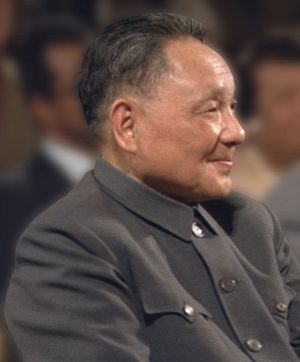Recently released British government files attest to a prior agreement between Japan and China to shelve their territorial dispute over the Senkaku/Diaoyu Islands. The files record a 1982 conversation between Zenko Suzuki and Margaret Thatcher, then the prime ministers of Japan and the U.K., respectively. In that conversation, Suzuki told Thatcher that he had reached an agreement with Chinese leader Deng Xiaoping to maintain the status quo on the disputed territories.
According to the British records, Suzuki and Thatcher were discussing how best to handle negotiations between China and the U.K. over Hong Kong, which was to be returned to Chinese control in 1997. Suzuki recommended that Thatcher deal directly with Deng Xiaoping himself, as Suzuki had “easily reached agreement” to “leave aside the differences of detail” over the disputed Senkaku/Diaoyu territories. “[I]n consequence it had been agreed that, without raising the matter concretely, the status quo should be maintained, so that the issue was effectively shelved,” the document paraphrases Suzuki as saying. Since Japan maintains administrative control over the islands, the “shelving” of the dispute and acceptance of the status quo could be seen as a diplomatic victory for Tokyo.
Yet as the Japan Times notes, the Japanese government has long denied that such an arrangement existed between Tokyo and Beijing. “Japan has consistently maintained that there has never been any agreement with China to ‘shelve’ issues regarding the Senkaku Islands. This is made clear by published diplomatic records,” the Japanese Foreign Ministry website says. This is in keeping with Tokyo’s official position that the islands are not under dispute – a position that remains unchanged despite a recent four-point consensus reached with China that acknowledges “different views” on tensions in the East China Sea.
China, meanwhile, has been far more open about the behind-the-scenes arrangement on the disputed territories. Asked about the British documents in a press conference, Chinese Foreign Ministry spokesperson Hua Chunying said that Chinese and Japanese leaders in the late 1970s “were thinking about the long-term interests of the two countries, and reached [an] important understanding and consensus on properly resolving the issue” of the territorial dispute.
China has openly referenced an unofficial agreement to honor the status quo since 2012, when the Japanese government nationalized the disputed islands. Though Japan’s national government said it had only made the move to prevent ultra-nationalist Tokyo mayor Shintaro Ishihara from purchasing the islands, Chinese officials were outraged, and accused Japan of violating the informal agreement to maintain the status quo. For Beijing, this effectively provided a rationale for China to also “unshelve” the dispute
Data from the Japanese Foreign Ministry show that the number of Chinese vessels entering the territorial waters around the Senkaku/Diaoyu Islands rose sharply in September 2012, just after the nationalization was announced, and have yet to fall back to pre-2012 levels. Between December 2008 and August 2012, there were only nine total incursions by Chinese vessels into the territorial waters of the disputed islands. In September 2012 alone, there were 13, and at least four Chinese vessels have entered the disputed region in every month since.
The Japanese government traces the problem farther back. Tokyo claims that China unveiled a “new position concerning the Senkaku Islands” in 2008, when two Chinese government vessels stayed in the islands’ territorial waters for nine hours. Tokyo claims that this 2008 incident demonstrated China’s “clear intention” of changing “the status quo through force or coercion.” Japan’s government argues that Beijing is merely using the 2012 nationalization of the islands as a “pretext” for increasing patrols in the disputed area.
In part, the changing approach toward the dispute simply represents the shifting geopolitical balance in the region. As Michael Green of CSIS pointed out in an interview with The Diplomat last year, the Senkaku/Diaoyu dispute is a microcosm of the larger geostrategic tussle between China and Japan. Simply put, the geopolitical context in the late 1970s, when the Suzuki-Deng agreement was reached, bears very little resemblance to East Asia today.
China’s own strategies have changed in response. As Xi Jinping made very clear at last year’s foreign policy work conference, China is moving away from the Deng-era focus on “keeping a low profile” in favor of what Xie Tao called “big strokes” in the foreign policy realm. To some observers, this shift includes a newer, more aggressive approach to territorial disputes in both the East and South China Seas. According to Tokyo’s logic, this strategy means Beijing would be aggressively pursuing control of the Senkaku/Diaoyu Islands regardless of any action taken on Japan’s part.
We can never say for certain what China’s approach to the Senkaku/Diaoyu Islands would have been if Japan had not nationalized the islands in 2012. Japan did purchase the islands from their private owner, and that proved to be the final nail in the coffin for the informal agreement to shelve the dispute. Despite a recent pledge to move bilateral relations forward in a spirit of “mutually beneficial cooperation and common development,” neither side seems willing to return to the days when the island dispute was on the back burner.

































